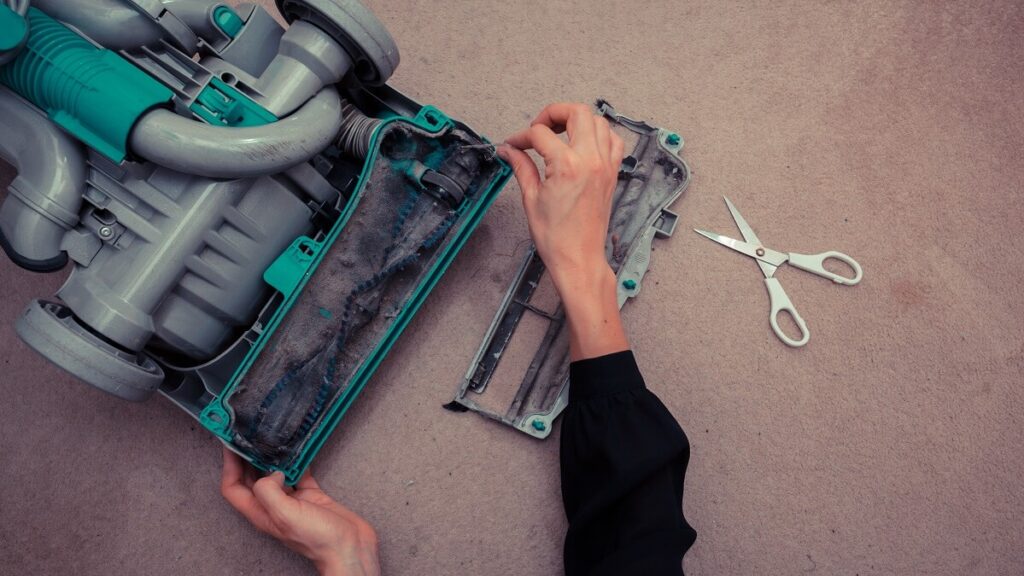Not every vacuum problem means you need to throw it out for a newer model. Here are some of the most common vacuum cleaner problems and what you can do to save your machine.
Read the manual
Before you get started trying to diagnose and fix the problem yourself, read the manual.
It will explain how to access and replace the filters, state which parts you can wash and offer other useful hints and tips for maintaining and troubleshooting vacuum problems.
The tips here are more general in nature so the manual for your vacuum will have specific instructions.
Warranties and your consumer rights
Another thing to check before grabbing the screwdriver is the warranty. If you try to fix a problem yourself, you could void the warranty.
If your machine is relatively new, then it should be covered by the manufacturer’s warranty, or should be covered under the Australian Consumer Law (ACL). In these cases, the manufacturer is probably responsible for repairing, replacing or refunding you for a faulty vacuum.
Once you’ve checked these two things off, here are some typical vacuum problems and the common culprits.
Loss of suction
If you’ve spent 10 minutes vacuuming a room with no visible results, your vacuum may have a suction problem.
Loss of suction often occurs when there’s a clog or obstruction in the system.
The first thing to check is that the bag or dust bin is not full. Next, check for a clog in the hose by disconnecting it from the vacuum head and body and giving it a good shake to see if anything falls out or rattles.
If you can feel an obstruction but can’t shake it free, use a broom handle to push it through.
If that doesn’t sort the problem, check you’re using the right setting. Vacuums often have different brush heights for floorboards, low-pile and high-pile carpets. Make sure you have it set correctly for the appropriate flooring.
Read: Eight common sources of household odours
The battery doesn’t last
According to CHOICE, the most common problems that Australian consumers have with stick vacuums is short battery life and the vacuum not picking up dirt.
“If your stick vacuum seems to be losing charge quickly or has low power, it could be worth purchasing a new battery,” says CHOICE expert vacuum tester Adrian Lini.
“Li-ion batteries slowly lose their charging capacity over time and this can really reduce the practicality and use of your stick vacuum.”
You can expect a battery life of around three to four years and, unless you have a very basic model, you should be able to take the battery out yourself.
Battery replacement usually costs around $100, which could be worth it for a high-end stick vacuum but might not be financially viable for cheaper models.
Clogged filter
Vacuum filters need to be cleaned around once a month to keep the machine running smoothly. The manual will tell you how to clean the filter. Often you can wash it with warm, soapy water. Just ensure you let it dry fully before putting it back. Keep in mind, HEPA filters usually can’t be washed.
If you bought your vacuum a few years ago, you may need to replace the filter. You can usually buy them directly from the manufacturer.
Read: The nasties hiding in your house dust
Brush roller not rotating
Hair and threads can become tangled in the brush roller, preventing it from spinning and doing its job.
The brush roller can typically be removed for cleaning. Refer to the manual to see how it’s done on your machine.
Cut any tangled hair or threads with scissors or a seam ripper and thoroughly brush away any lint and dust.
The vacuum won’t stay on
In most vacuums, when the motor begins to run too hot, a feature immediately shuts it off to keep it from burning out.
The sensor can be triggered if the hose is clogged or the filter hasn’t been cleaned for a while. So try a deep clean before anything else.
If it still dies out, you might need to replace a small thermal fuse. Your local vacuum store can often sell you the fuse and help you replace it.
It’s extra noisy
If your vacuum is working but making a very high-pitched squeal, you could have an airflow issue. Remove and clean your hoses and filters to remove any obstructions, or replace them as needed to make the screeching stop.
It could also be a problem with the belt. When belts aren’t attached or are on their way out, they can cry out for attention with a lot of noise.
“The roller brush in the cleaning head is sometimes driven by a rubber belt, which can wear out, break or slip off the roller drive wheels,” says CHOICE household expert Chris Barnes.
“Putting it back in place or replacing it is usually an easy enough DIY job.”
If it’s not an obstruction or belt issue, it may mean the motor is wearing out.
Read: Should I buy a cordless vacuum?
Consult a professional
There are some issues you just won’t be able to diagnose or fix yourself, so you may have to consult a professional. Weigh up whether it’s worth the expense before making the trip.
For cheap vacuums, a repair is probably more costly than just getting a new one (unless it’s still under warranty, of course).
Depending on the upfront cost, a vacuum cleaner should last for four to 10 years. Repairs can be worthwhile for more expensive models.
Which vacuum cleaner do you have? Would you recommend it? Please share why or why not in the comments section below.

